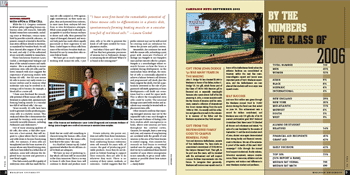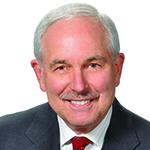National Debate, Wish Upon A Stem Cell
 While the U.S. Congress continues to debate policy regarding human embryonic stem cell research, federally funded researchers nationwide, including some at Wesleyan, remain tantalized by possible scientific advances. At present, research is limited to the 60 human stem cell lines already in existence, as mandated by President Bush. No cell lines derived after August of 2001 may be used, and only 17 of the authorized 60 are currently available to researchers.
While the U.S. Congress continues to debate policy regarding human embryonic stem cell research, federally funded researchers nationwide, including some at Wesleyan, remain tantalized by possible scientific advances. At present, research is limited to the 60 human stem cell lines already in existence, as mandated by President Bush. No cell lines derived after August of 2001 may be used, and only 17 of the authorized 60 are currently available to researchers.
These limitations frustrate Laura Grabel, a developmental biologist and dean of the natural sciences and mathematics. She is an authority on mouse embryonic stem cells (ES cells) and believes research with mice suggests the importance of pursuing studies with human ES cells. Her lab uses mouse ES cells to mimic very early events in a mouse embryo and to examine what molecular cues may be involved in directing a cell to become, for example, a blood cell or a nerve cell.
“I have seen first-hand the remarkable potential of these mouse cells to differentiate in a plastic dish, spontaneously forming beating muscle or a vascular tree full of red blood cells,” she says.
“Most recently, ES cells have been used to generate insulin-producing pancreas cells in a diabetic mouse. This study and others like it demonstrate the potential for treating a wide variety of currently incurable diseases, including Parkinson’s and Alzheimer’s.”
One of many amazing qualities of ES cells, she notes, is that after injection into a host animal, they will migrate to a place where they’re needed, and settle down to become functioning cells. For instance, if stem cells are transplanted into the bone marrow of a mouse whose own blood-forming stem cells have been killed by a lethal dose of radiation, some will colonize the depleted bone marrow and generate a new blood supply.
This find-a-need-and-fill-it quality of embryonic stem cells has made the human ES cells isolated in 1998 agonizingly controversial. As their name implies, they are harvested from embryos, in most cases from embryos left over from in vitro fertilization attempts. While some people find it ethically unacceptable to sacrifice human embryos to derive such cells, their potential for repair of damaged, diseased, and wornout body parts has made others equally passionate in their eagerness to use them. Grabel hopes to obtain cells from some of the 60 lines President Bush authorized for use by researchers who receive federal funds.
“We have got so much experience working with mouse ES cells, I just think that we could add something to characterizing the human cells—how they’re different from the mouse cells, how they’re the same,” she says.
In a Hartford Courant op-ed, Grabel questioned whether the 60 cell lines cited by Bush are adequate.
“We have no way of predicting today which cell lines will be successful in the clinic tomorrow. There is no way to know if cells from these lines will continue to divide and produce more stem cells or be able to generate the kinds of cell types needed for transplantation studies.
“And what if they can’t? What if the cell line that best generates precursors of neurons lost in Parkinson’s disease is not among the 60 cell lines? What if it is found in the coming year?”
Private industry, she points out, does not suffer from these limitations. Corporations such as Geron have been conducting human embryonic stem cell research for years with, of course, the goal of producing profitable products. Since they do not depend on federal funding to support their research, they are able to do whatever they want. There is no scrutiny of their intent, methods, or outcomes. Grabel suggests that the public interest may not be well-served by creating such an imbalance between the private and public sectors.
Meanwhile, she continues her work with the mouse cells, submitting a joint grant with Associate Professor of Biology Jan Naegele to use Naegele’s mice and her own ES cells for a project. Naegele is a neurobiologist whose research focuses on how the brain is sculpted during development. As the mammalian brain develops, the number of cells is continually adjusted to achieve a balance between cell division and programmed cell death (lest the brain outgrow the skull). Her lab is particularly interested in the role of programmed cell death (apoptosis) in brain development—cell death can sometimes lead to a need for repair work. This is where the transplanted stem cells could be useful. The neuronal damage associated with strokes and accidents may someday be treated with replacement stem cells.
Other research confirms that repairing damaged neurons may not be the impossible task it was once thought to be. Associate Professor of Biology John Kirn studies adult neurogenesis in birds, where new neurons are born throughout the cerebral cortex. Canaries, for example, learn a new song each year, and seasons of song learning are correlated with the growth of new neurons in the area of the brain known to control singing. Kirn connects his research on bird brains to eventual medical uses for people, saying, “Why don’t we try to understand those limited number of cases where neurogenesis occurs naturally, to get as much information as possible about how nature does this?”
Download a PDF of the complete article HERE

